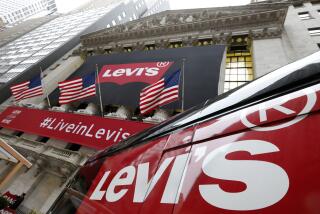American Apparel reports $16.2-million loss in second quarter

American Apparel Inc., bedeviled by turmoil in the executive suite, reported a larger-than-expected loss in its second quarter as the retailer struggled with flat sales and worked to secure fresh credit from borrowers.
The Los Angeles retailer, which ousted founder Dov Charney as chief executive in June, said it lost $16.2 million, or 9 cents a share, for the three-month period.
That’s an improvement over last year’s second quarter, when American Apparel lost $37.5 million, or 34 cents a share. But the clothing maker said last month in delaying the release of its financial results that it expected to lose $15 million.
Sales were flat at $162.4 million. Sales at stores open more than a year, a key measurement, fell 6%, but revenue from wholesale operations continued to improve, jumping 9%.
In releasing its quarterly financial results, American Apparel’s executives did not provide any commentary in its statement about the company’s operations as they usually do.
Its shares rose 5 cents to 94 cents Monday, but have slid nearly 24% this year.
American Apparel has gone through severe upheaval since its board voted to remove Charney as chairman and suspend him as chief executive June 18, citing allegations of misconduct and inappropriate behavior with employees.
Ousting Charney put the retailer in danger of defaulting on a loan from creditor Lion Capital. Charney also indicated that he was willing to wage a protracted fight for control of the company.
Charney ultimately joined forces with New York investment firm Standard General, which now controls a nearly 44% of the company through a cooperative buying arrangement with the founder. He agreed to work as a paid consultant for American Apparel pending the results of an investigation into his personal behavior.
Standard General committed up to $25 million in financial help to American Apparel, essentially guaranteeing that the company would not teeter into bankruptcy in the near term. Last month, the company bought a $10-million loan from Lion Capital to help bolster its finances.
On Monday, American Apparel said it was negotiating with several parties, including at least one of its foreign subsidiaries and Standard General, to get a credit agreement “as soon as practical.”
As part of the deal with Standard General, Charney and four other members of the board resigned. Five new board members have been appointed, including its first two female directors.
The investigation into Charney’s conduct by FTI Consulting Inc. is ongoing. Among his problems, Charney is accused of misusing company funds and allowing the posting online of nude photos of a former employee who was suing him.
Whatever the outcome for Charney, American Apparel faces a daunting task to turn around its financial fortunes. It has lost nearly $270 million in the last four years and is more than $200 million in debt. In March, it sold $28.6 million in stock to meet debt obligations.
The company faces an October deadline to pay bondholders $13.5 million in interest.
Its financial difficulties have sparked rumors that the company may be sold, speculation that American Apparel executives have adamantly denied.
Some analysts said the retailer, which has built is reputation on its made-in-America manufacturing and provocative advertising, may have to move a part of its operations overseas to cut costs.
Charney has said the company’s problems can be blamed in part on a rocky start to a new distribution center in La Mirada and the firing of 1,800 employees in 2009 after an immigration inspection.
“The financial challenges at the company had nothing to do with our cost of manufacturing in Los Angeles,” he told The Times last month.
Twitter: @ByShanLi







